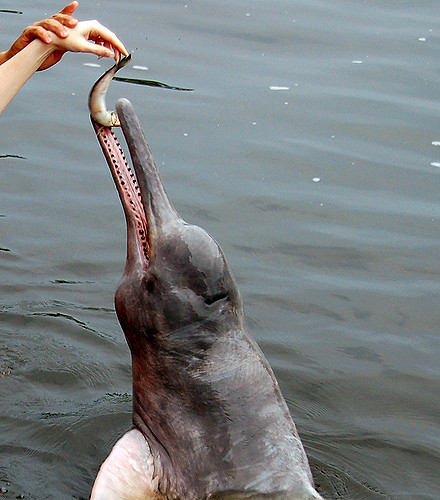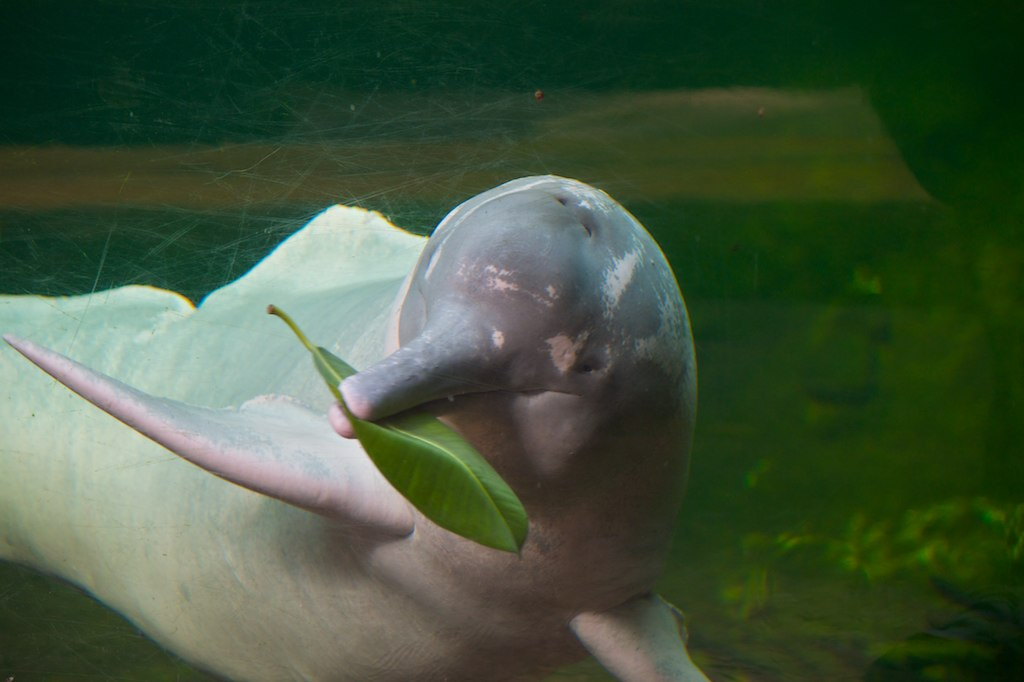Represented in the media as friendly and highly intelligent creatures, dolphins have always received quite a bit of attention from animal lovers. The pink river dolphin, also known as the Amazon River dolphin or Boto, is a freshwater subspecies with a lot of personalities. We’ve compiled a list of pink river dolphin facts to help travelers learn about this rare species as they travel to places to see these amazing creatures.
Read Gondwana’s Top 5 Pink River Dolphin Facts:
1. Amazon River Dolphin Internal Sonar & Communication
 Though they live in occasionally dark water and have sub-par eyesight, dolphins still need to interact with other animals and their environment. Saltwater and freshwater dolphins both use sonars and clicks to communicate, but their environment makes them use this skill in different ways. In the shallow, vegetation-dense rivers, dolphins need to emit more clicks because foreign objects are closer than in the ocean. The pink river dolphins emit about 30 clicks per second in order to navigate the lush, loud environment of the Amazon River.
Though they live in occasionally dark water and have sub-par eyesight, dolphins still need to interact with other animals and their environment. Saltwater and freshwater dolphins both use sonars and clicks to communicate, but their environment makes them use this skill in different ways. In the shallow, vegetation-dense rivers, dolphins need to emit more clicks because foreign objects are closer than in the ocean. The pink river dolphins emit about 30 clicks per second in order to navigate the lush, loud environment of the Amazon River.
2. Boto Extinction & Threats
In the movie Hitchhiker’s Guide to the Galaxy, dolphins “…long ago knew of Earth’s planned destruction and tried to communicate this to humans who misinterpreted it as “amusing attempts to punch football or whistle for tidbits.” Despite the comedic intentions, the message of this quote rings true for pink river dolphins specifically. Deforestation, commercial fishing and habitat loss have harmed the dolphin’s ecosystem and population, challenging their ability for them to swim and breed along their normal routes. Pollution also impairs the internal sonar, making it difficult for them to navigate directions and objects in the water.
3. Pink River Dolphin Colors & Emotions
Though more prominent in males than females, the pink coloring of this species gives the dolphins a distinctive look compared to their ocean-dwelling relatives. Dolphin calves start life as a gray color, then become lighter gray and eventually pink as their skin and capillaries are exposed to the elements. Temperature, water quality and trauma can impact the colouring of individual Amazon River dolphins. Similarly, emotions like surprise and happiness can create a pink hue, similar to how humans blush when they have these feelings.
In addition to their unique coloration, Amazon River dolphins are known for their social behavior and complex communication. These intelligent creatures have developed a variety of clicks, whistles, and body language cues that allow them to navigate the murky waters of the Amazon basin with ease. Their intricate social structures involve cooperative hunting, parenting, and even play behaviors that help strengthen bonds within their pods. Studying the behavior of these pink dolphins not only sheds light on their fascinating adaptations to their environment but also provides valuable insights into the interconnectedness of marine ecosystems.
4. Amazon River Dolphin Brain & Intelligence
 Dolphins World writes, “Amazon pink dolphins are considered the most intelligent of them, with a brain capacity 40% larger than that of humans.” Both saltwater and freshwater dolphins are known for positive interactions with humans and the ability to learn new skills. This, coupled with knowing that they have feelings makes them a remarkable animal, mentally and emotionally.
Dolphins World writes, “Amazon pink dolphins are considered the most intelligent of them, with a brain capacity 40% larger than that of humans.” Both saltwater and freshwater dolphins are known for positive interactions with humans and the ability to learn new skills. This, coupled with knowing that they have feelings makes them a remarkable animal, mentally and emotionally.
Amazon pink dolphins exhibit remarkable cognitive abilities beyond just brain size. Researchers have observed their sophisticated communication skills, intricate social structures, and problem-solving capabilities. Their unique pink hue adds to their mystique, captivating the imaginations of people worldwide. As ambassadors of the aquatic realm, these dolphins continue to fascinate and inspire us with their intelligence and emotional depth.
5. Buti Legends & Tribal Significance
The pink river dolphin has been sacred to the indigenous tribes of the Amazon for thousands of years. There are stories of river dolphins saving people by guiding them to shore. There are even tales of shape-shifting, where they change into humans to seduce women on the beach. Amazonian tribes live in the same ecosystem as the river dolphins, and these animals are embedded in their folklore and history.
The deep-rooted connection between the indigenous tribes of the Amazon and the pink river dolphins goes beyond mere folklore; it signifies a profound bond between humans and nature. As guardians of the Amazon rainforest, these tribes have long understood the importance of preserving the delicate balance of their environment, with the river dolphins symbolizing the harmony and interconnectedness of all living beings in their ecosystem. The stories of shape-shifting and supernatural abilities attributed to the river dolphins reflect a spiritual reverence for these majestic creatures, highlighting their significance as spiritual guides and protectors of the Amazonian tribes.
Pink River Dolphins & The Amazon Awakening Tour
These pink river dolphin facts are just a fraction of the interesting things about this exotic animal. Spend time among the Amazon River dolphins on one of the many nature focused adventures on Gondwana’s Amazon Awakening Tour, all while staying with the Achuar, an indigenous tribe deep in Ecuador’s Amazon Rainforest.
Read about the birds of the Amazon, including macaws, toucans, parakeets, and parrots, paint the sky with vibrant hues in this biodiverse ecosystem. Their brilliant plumage and melodic calls add to the enchanting tapestry of the rainforest, captivating observers worldwide.

Amazon River Dolphin



